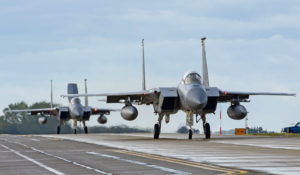
SZYMANY, Poland — Service members from the 10th Army Air and Missile Defense Command, U.S. Air Forces in Europe and U.S Air Forces Africa, along with five other NATO countries conducted Astral Knight 20, a joint multinational air defense exercise, Sept. 12-25 near Szymany, Poland.
Astral Knight 20 was designed to enhance interoperability among NATO allies and partners to increase readiness through the integration of land component air and missile defense capabilities.
Astral Knight 20 took place in various locations across Europe. Air defense forces and the Air Operations Center were located in Poland, while aerial and mission command elements simultaneously operated from Italy and Germany. Service members from Estonia, Latvia, Lithuania, Poland, Sweden and the United States were involved with Astral Knight 20.
“The purpose of this exercise is establishing datalink architecture and utilizing different systems to understand our capacity and capability,” said Brig. Gen. Gregory Brady, Commander of the 10th AAMDC, during a Brussels Media Hub engagement. “When you build these different systems together, you can have four or five different physical languages, different mission command elements, different interceptors, but your goal is to establish one single integrated air picture to understand early warning and building upon that situational awareness from a command and control perspective.”
The exercise combined both aerial and ground assets from a joint combined air picture. Aerial assets incorporated a variety of U.S. Air Force and Polish Air Force aircraft, including elements of a theatre bomber task force. Ground assets included air defense assets such as the 10th AAMDC’s Patriot missile systems and Poland’s 3rd Air Defense Brigade’s SA-3D ground-based missile system.
Training in the Baltic region is aimed to enhance flexibility and interoperability in the interest of strengthening combined response capabilities and demonstrating international resolve. The threat scenarios involved a variety of aircraft, unmanned aerial systems, and tactical ballistic missiles with live flyover, simulations and injects to more effectively prepare and maintain cohesion during any joint multinational conflict in U.S. Army Europe.
Maj. Gen. Derek France, Director of Operations for U.S. Air Forces in Europe and U.S Air Forces Africa, explained the reason behind building complex scenarios during these exercises during a Brussels Media Hub engagement. “We have forces that are capable of engaging each of those, and when we talk about command and control, which is one of the focus areas of this. It’s about putting the right force to defend against the right threat and the right place at the right time,” said France.
The air defense units involved in this exercise had to work together in Szymany, Poland in a joint multinational environment to defeat and deter the threats. The success of this interoperability was due largely to the strong trust these units have in one another, which comes thanks to the relationships they have built and maintained.
“Training alongside our joint partners and NATO allies is critical,” said Capt. Mellorie Clinton, Delta Battery Commander assigned to 5th Battalion, 7th Air Defense Artillery. “Our ability to operate in a real world combat situation relies on so many of our allies. We make sure we train with our air defense counterparts consistently. Training solidifies our interoperability.”
Clinton explained that exercises such as Astral Knight 20 provide units with a unique opportunity to work effectively together and overcome cultural barriers.
“It is incredible to build on past and present relationships with our allies,” said Clinton. “For example, Capt. Bartosz Rozek, Group Commander in the 3-7 Air Defense Squadron from Poland and I went to Air Defense Captains Career Course (ADA CCC) together at Ft. Sill, Oklahoma. This unique opportunity has allowed us to work more effectively and speak the same tactical and technical language.”
Capt. Rozek also commented on the benefit of training in a combined environment like Captains Career Course, and how it benefited the Astral Knight 20 exercise for air defense forces at Szymany.
“ADA CCC gives a one of a kind opportunity to create both professional and personal bonds that pay off during multinational exercises like Astral Knight 20. Thanks to that experience, allied officers such as myself have more of a shared understanding and can easily participate in discussion and join all efforts,” Rozek said.
True interoperability is comprised of three things: people, processes and equipment. Astral Knight 20 was an exercise designed to combine all of those things effectively to create a joint multinational air picture with the ability to defend and deter against various threats.
“All of our NATO allies have different capabilities that provide a multi-layered approach. There isn’t one interceptor that can defeat all threats,” said Brig. Gen. Brady. “So the ability to synchronize the capabilities, understand what our allies have, and then build this architecture really leads to readiness – and readiness matters.”


